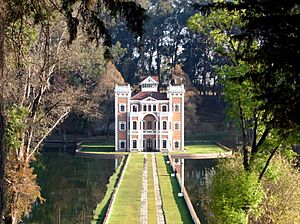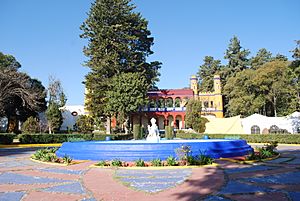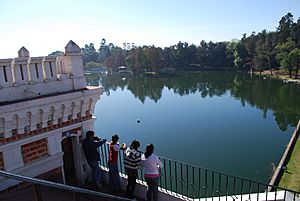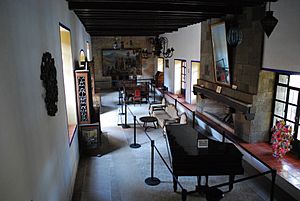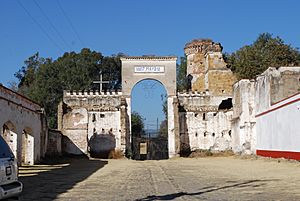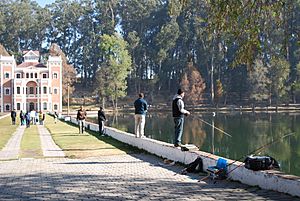Chautla Hacienda facts for kids
The Chautla Hacienda is a historic estate in the state of Puebla, Mexico. It was once a huge farm, first built in the 1700s. Back then, it mostly grew grain. Later, in the 1800s, an Englishman named Thomas Gillow owned it.
His son, Eulogio Gillow, took over and made many improvements. He even built the first hydroelectric dam in Latin America right there! Eulogio also built a special English-style house. People call it "El Castillo," meaning "The Castle." Today, only a small part of the original hacienda remains. It is now a fun place for visitors, run by the state of Puebla.
Contents
Discovering Chautla Hacienda
The Chautla Hacienda is located in the San Martin Texmelucan Valley. It is about eight kilometers from the city of San Martin Texmelucan. The hacienda sits between Mexico City and Puebla. Long ago, a main road nearby helped transport farm goods. These goods went to big cities like Mexico City, Puebla, and Veracruz.
The area has a slightly cooler and wetter climate. The property is surrounded by what used to be large forests. The entire hacienda covers about sixty hectares. Thirty-five hectares are forest, and twelve hectares are water. The property includes the old main house, a lake, and the famous "El Castillo."
The Main House and Gardens
The main house was first built by the Marquis of Selva Negra. He was the first owner of the property. Different parts of the house were built at different times. It sits on a high spot, looking over the estate. Old trees, some centuries old, surround the house.
Visitors enter through a side door into a central courtyard. A fountain built in 1941 is in the courtyard. It is decorated with colorful Talavera plates and tiles. Across from the fountain is a small chapel. The building has small watchtowers on its four outer corners.
The hacienda also has a museum inside the main house. It shows old photos, paintings, and furniture. You can see how people lived in the salon, kitchen, dining room, and bedrooms. Next to the main house are the remains of old horse stables. To see the rest of the property, you walk into the east garden. This garden has a large white fountain and two reflecting pools. Paths in this garden lead to the lake and "El Castillo."
The Lake and "El Castillo"
The lake was created by a dam built in the late 1800s. It covers about twelve hectares of land. A land bridge divides the lake into two parts. This bridge leads to "El Castillo," the most famous building here.
"El Castillo" is an English-style house. It was built to be a home for teachers at an agriculture school. It is made of brick with white details. Above the main door, you can see the year 1898. This was when it was finished. The front of the building faces the land bridge. From here, you can see the whole lake.
Fun Activities at Chautla
The Chautla Hacienda used to be private. Now, it is a public place for fun and learning. A state agency helps manage it. They highlight the main house, "El Castillo," the lake, and the surrounding forest.
You can enjoy many activities here. These include sportfishing, camping, and picnicking. You can also rent parts of the hacienda for special events. "El Castillo" is very popular with visitors. You can go up to its roof for great views. Its restaurant, also called "El Castillo," serves delicious trout dishes.
Fishing in the lake is another favorite activity. The lake is stocked with trout and other fish by an organization called "Amatzcalli." You can find a small store, a bait shop, and boat rentals. Fishing lessons are also available for those who want to learn.
Chautla Hacienda's Past
The Chautla Hacienda began with Manuel Rodriguez de Pinillos y Lopez. He received the title of Marquis of Selva Nevada in 1777. However, he never lived there. Chautla was one of many large farms in the valley. These farms were very important to the local economy long ago.
The hacienda was started because of its natural resources. It had plenty of water and fertile land. There were also many local workers available. Its location near big markets was also a plus. The good climate and water made it perfect for growing grain. At first, it grew corn and wheat on about 6,000 hectares. This land included areas that are now many smaller farms and villages.
The Gillow Family Takes Over
The hacienda later passed to Soledad Gutierrez de Rivero Martinez de Pinillos. She was the fourth Marchioness of Selva Negra. She had a daughter named Mara Zavala y Gutierrez. In the 1820s, Soledad married an Englishman named Thomas Gillow.
Thomas Gillow was born in Liverpool, England, in 1797. He came to Mexico in 1819, during the Mexican War of Independence. He became a well-known jeweler in Mexico City. This helped him meet and marry the Marchioness. After marrying, Gillow focused on running the estate.
After the Marchioness died, Thomas married her daughter, Mara. This marriage helped solve some problems with the estate's inheritance. Thomas and Mara had a son named Eulogio Gillow.
Mara died in 1861, and inheritance problems came up again. Thomas Gillow received the Chautla Hacienda. He sold a small part of the estate in 1870. These were the first lands to be separated from the main property. When Thomas died in 1877, Eulogio inherited the remaining lands. Under Eulogio, the hacienda grew wheat and maguey plants. He worked hard to bring new technology and better ways of working to the farm.
New Ideas and First Hydroelectric Plant
Eulogio Gillow brought electricity to the hacienda in 1903. He built Latin America's first hydroelectric power plant there. His father, Thomas, had brought the first metal plough from England. But it wore out quickly. So, Thomas helped a man named Mr. Marshall start an iron factory in Puebla. Marshall became very rich making and fixing farm and textile machines.
Eulogio also bought other new machines. One was a threshing machine from the United States. Sadly, this machine did not work well at Chautla. The grain grown there was different from U.S. varieties. The threshing machine was left to rust. Eulogio even offered to give it to the Smithsonian Institution. But he wanted a big sign saying it was useless in Mexico! Eulogio also wanted to start an agricultural college. He built the English-style house ("El Castillo") on the dam to house the teachers. It once had a drawbridge, artificial lakes, and beautiful gardens.
Changes During the Mexican Revolution
Eulogio was a priest and well-liked by important people. He was a friend of Porfirio Díaz, who was Mexico's president. Eulogio even helped with Díaz's wedding in 1881. In 1887, Eulogio became the Bishop of Antequera (Oaxaca). Four years later, he became the first Archbishop of Antequera. As Archbishop, he helped build schools and protect old buildings. He also pushed for a railway line between Mexico City and Oaxaca.
Eulogio lost most of the hacienda's lands during the Mexican Revolution (1910-1921). This happened when people fought against the old system of large estates. In 1914, these lands were given to local farmers. Many of the hacienda's buildings were destroyed during the war. Furniture and important papers were also lost.
A Public Place for Fun and Culture
Eulogio went to the United States and lived in Los Angeles. He came back in 1921 after the war ended. He was able to get back 150 hectares of the hacienda. He received this land shortly before he passed away. His family later sold off parts of this land. Eventually, the remaining sixty hectares were sold to the state of Puebla.
Since then, the Chautla Hacienda has been a recreational and cultural center. It has also been used to film Mexican TV shows. Some of these include "Dulce desafío", "Pueblo chico, infierno grande", and "El Maleficio." In 2000, the "Amatzcalli" organization helped restore the lake. They stocked it with trout and other fish for sportfishing.
See also
 In Spanish: Hacienda de Chautla para niños
In Spanish: Hacienda de Chautla para niños


